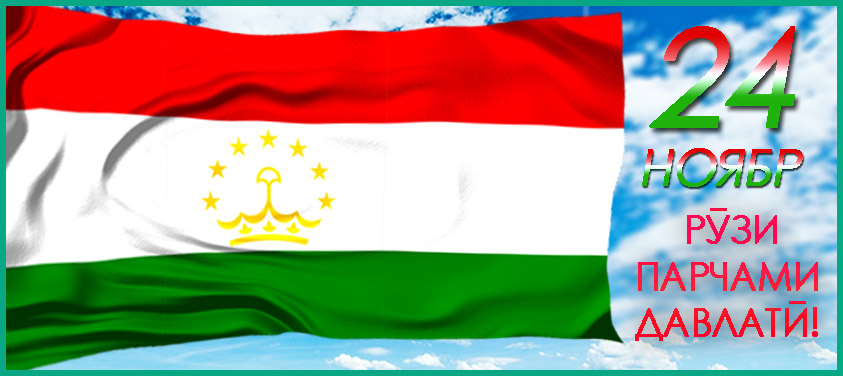Happy National Flag Day, dear compatriots!
On November 24, Dushanbe hosts the official raising ceremony of the Main Flag of Tajikistan, on the square at the highest flagpole in the world. The main flag of the country, attended by members of the public and young people, and a concert of Tajik pop stars. The flag is based on three colors: the red stripe symbolizes freedom and independence, white - peace and tranquility, and green - prosperity. In the center of the flag there is a crown with a semicircle of seven stars, denoting seven historical and cultural centers of Tajikistan. The state flag was adopted as the first symbol of the independent Tajik state on November 24, 1992 at the XVI session of the Supreme Soviet of the Republic. In honor of this symbol, on November 20, 2009, the President of the country declared November 24 as the Day of the State Flag of Tajikistan by its decree.
COLORS MEANING OF THE FLAG
When creating new state symbols of Tajikistan were guided by the principle of historicism and continuity. The Flag of Tajikistan by its red-white-green color scheme repeats the Flag of the Tajik SSR.
According to the Regulation on the State Flag of the Republic of Tajikistan, adopted on November 24, 1992, "The State Flag of the Republic of Tajikistan is a symbol of the unbreakable union of workers, peasants and intellectuals". Workers are symbolized by red color, peasants - green, intellectuals - white.
The flag of Tajikistan is a rectangular cloth of three horizontal stripes of red, white and green colors of different widths (2:3:2). In the center of the cloth on the white (middle) stripe depicts a stylized golden crown, framed at the top by a semicircle of seven gold five-pointed stars. The ratio of the width of the flag to its length is 1:2.
The semantic interpretation (explanation) of the meaning of colors on the flag is rooted in the ancient history of the Tajik people. By the way, the flag of the Tajik SSR, approved in 1953, had the same color scheme (red, white and green). These colors symbolize the class structure of ancient Iranian society, where red was the color of military nobility, valor, nobility, white was the color of the clergy and a symbol of spiritual purity and holiness, and green was the color of free people, a symbol of nature, life and prosperity. The alternative interpretation of colors is similar: freedom and independence (red), peace (white) and prosperity (green).
The stylized golden crown surmounted by a semicircle of seven golden five-pointed stars is an element of the national emblem of the Republic of Tajikistan and symbolizes state sovereignty and independence. The explanation of the meaning of the seven stars also varied. Originally, the stars symbolized seven prominent poets from the history of the Persian-Tajik people. Today, these stars designate seven historical and cultural districts of Tajikistan.
The flag in the immortal poem "Shahnameh" by Firdavsi
It has flown on the highest point of Antarctica and for almost seven months - in space! In the history of civilization and ancient culture of Tajik statehood, the flag and flag bearer have an interesting and long history. It is reflected in ancient written works, myths, historical and literary sources, stories, legends, legends and oral folk art. In these works the flag is glorified as a symbol of freedom, courage and bravery.
Flag selection among 200 projects
A few months before the date of adoption of the State Emblem and the State Flag of Tajikistan, a competition was announced, which was held in closed mode. More than 200 designs were submitted to the contest, each of which was studied and evaluated by a special commission headed by Academician Muhammad Osimi. The proposed projects represented only a three-color fabric (cloth with three colored stripes), each color representing the content of the past and present history of the Tajik people. That is, red represented freedom, white represented peace, and green represented prosperity of the state and nation.
Finally, the State Commission selected the draft of the State Flag and the State Emblem prepared by Z. Habibulloev, A. Zanevsky, L. Dodkhudoeva, N. Ignatushina and M. Saidaliev and completed its work. The beginning of the civil war created an obstacle for the development and adoption of new state symbols, only on November 24, 1992 in the palace "Arbob" Khujand, at the historic XVI session of the Supreme Council of the Republic of Tajikistan were adopted a new State Emblem and State Flag.
During its modern history, Tajikistan, under the flag of an independent State, has become a full member of the United Nations and other authoritative international organizations, and relations of friendship and cooperation, including diplomatic, economic and cultural ties, have been established with many countries of the world.
It is a source of pride for each of us that today, along with the flags of other Member States of the United Nations, the flag of independent Tajikistan also flies in front of the building of this influential international organization. The national flag, which is an expression of unity, honor, dignity, patriotism and national identity of the culture-honoring Tajik people, reflects in its colors the aspirations and goals of the Tajik people.
Tayfurova Shakhlo Nazaralievna
Assistant at the department of obstetrics and gynecology №2
translated
Ismoilov R.

